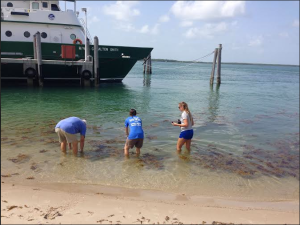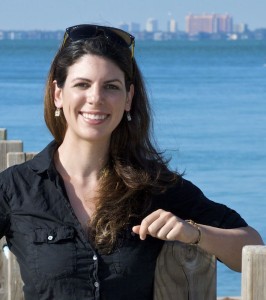
Volunteers with Biscayne Bay Water Watch collect water samples to monitor the water quality of the bay. With funding from NOAA, water quality samples will be put into a GIS database to show which areas of the Bay are most at risk to algal blooms.
The blue, shimmering waters of Biscayne Bay are estimated to contribute about 10 percent to the Miami-Dade economy each year. Activities related to Biscayne Bay generate $12.7 billion in economic output, $6.3 billion in incomes 138,000 jobs, and $627 million in tax revenue to the local economy annually.
However, over the last decade, several unprecedented algal blooms have threatened the quality, health and beauty of the Bay, impacting its marine life and over 10,000 acres of bay bottom habitat.
Miami Waterkeeper, in partnership with Florida Sea Grant, UF/IFAS Extension Miami-Dade County and the University of Miami, has recently been awarded $117,667 from NOAA’s Habitat Blueprint Initiative, administered by the NOAA National Marine Fisheries Service to help ensure the Bay’s health for future generations.
Rachel Silverstein, a 2013 Knauss fellow, and executive director of Miami Waterkeeper will be administering the grant. Silverstein is also known for her work protecting staghorn coral threatened by the dredging conducted as part of recent Port of Miami expansion efforts.
According to Lisa Krimsky, the Florida Sea Grant agent with UF/IFAS Extension in Miami-Dade County, Biscayne Bay was chosen as a new focus area because scientists and resource managers worry that it may be reaching a “tipping point” and may not be able to rebound from excess nutrient inputs and algal blooms.
Krimsky will be using part of the grant funding to expand the Biscayne Bay Water Watch program. The program is a community-based volunteer water quality monitoring program that raises awareness about the health of the Bay and the importance of the water quality on the local environment and economy.
Among the main objectives the partners hope to accomplish with the two-year grant funding is conducting an economic valuation study of Biscayne Bay. The study will be conducted by Manoj Shivlani, a fisheries economist at the University of Miami’s Rosensteil School of Marine and Atmospheric Science.
The grant funding will also go toward creating a GIS database of Biscayne Bay to identify water pollution hot spots and areas most at risk for harmful algal blooms.

Rachel Silverstein, a 2013 Knauss Fellow, will be administering the NOAA grant to help keep Biscayne Bay healthy. Silverstein is also known for her work moving corals threatened by a Port of Miami dredging project.
But Krimsky also wants to make sure elected officials are part of the target audience. The funds from the grant will also help establish a Water School program to educate officials about the Bay. The program will be co-led by Florida Sea Grant and Miami Waterkeeper.
Krimsky also received seed funding for both of these programs from a Wells Fargo Extension Professional and Enhancement Award.
“I am very excited to be able to expand both of these critical programs. Algal blooms have been threatening Biscayne Bay for more than a decade, yet very few people, including our elected officials are aware of the Bay’s vulnerable status,” Krimsky said.
“In fact, funding and water monitoring in the Bay has declined over this period. Biscayne Bay Water Watch is filling an important niche by continuing to monitor lost bay-wide monitoring stations. NOAA has recognized that citizen science programs are capable of providing valid and useful data.”
Finally, the funds will help Miami Waterkeeper establish a Junior Waterkeepers program to educate elementary, middle and high school students about Biscayne Bay.
“We can’t wait to get to work on these exciting and important programs, and are very grateful to NOAA for recognizing the value of Biscayne Bay and providing this funding to protect it,” Silverstein said.



